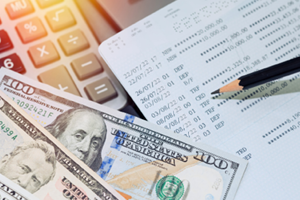The recent run of inflation is causing many people to rethink how to save and where to spend. In this month’s newsletter, there is a recap of the traditional role of how your bank accounts work together to provide a valued resource to handle your funds. There’s also a great article on how to identify and manage against shrinkflation.
Plus there are a couple of timely tax articles including a review of common tax surprises and suggestions on making sure you get the most out of the recently increase standard mileage rates recently announced by the IRS.
Please feel free to forward the information to someone who may be interested in a topic and call with any questions you may have.
Layering Your Bank Accounts

Time for the classic banking approach to make a comeback?
For years, savings and checking accounts provided very little in the way of interest income. In our current inflationary times, however, interest rates are on the rise. What is also on the rise is the comeback of traditional banking products. Here is a review of how your bank accounts traditionally work together as a team to provide you the best security and value for your money.
The checking account: 30 days of funds
- Primary Purpose: Checking accounts enable financial transactions. So store enough money here to pay immediate expenses. With checking accounts, you’re allowed numerous withdrawals and unlimited deposits. The tradeoff for having an account where cash is available at a moment’s notice is usually a much lower (or practically non-existent) interest rate.
- Action Item: Determine what your 30-day cash needs are and limit the available cash in your checking account to this amount. Also consider setting up a link to another account. Most banks allow this so you do not have overdraft fees. Consider looking for a checking account that also allows an automatic sweep function of excess funds into a higher-interest savings account.
Basic savings account: 2 to 6 months of funds
- Primary Purpose: To store your money in a secure location so you can use it to pay periodic expenses that are expected over the next 2 to 6 months. This is also where many store their emergency fund. While these accounts typically pay only a modest amount of interest, their safety and reliability make savings accounts a great choice for stashing cash you want available sometime within the next 12 months. This is often also your overdraft buffer in case your checking account gets overdrawn.
- Action Item: Calculate your anticipated periodic expenses over the next 6 months, and limit the cash in your savings account to this amount. You don’t want the balances too high, as you can typically get better interest in other bank products AND if a thief gets access to your debit card, you can limit the damage they do if this savings account is linked to your checking account.
Higher-interest bank accounts: Lots of choices
- Primary Purpose: There are several types of bank accounts for storing your money beyond what you need for short-term expenses. High-yield savings accounts, money market accounts, and certificates of deposit (CD’s) all provide at least 10x the interest return compared to a regular savings account. But in return for a higher interest rate, there are rules that govern how long you need to leave your money untouched in these accounts.
- Action Item: Review your bank’s alternatives for longer-term savings. Pay attention to interest rates and how often they adjust with the market. If CD’s are your bank’s strength, consider building a ladder of expiration dates to make your money more available. On high-yield accounts, the interest rate often increases with higher balances, so know what products these are. It’s also a good idea to talk to your banker to review your options.
When you’re trying to decide where to keep your money, there are also tax ramifications to consider. So keep this in mind as you review how your bank accounts work together as a team.
Watch for These Tax Surprises

Our tax code contains plenty of opportunities to cut your taxes. There are also plenty of places in the tax code that could create a surprising tax bill. Here are some of the more common traps.
- Home office tax surprise. If you deduct home office expenses on your tax return, you could end up with a tax bill when you sell your home in the future. When you sell a home you’ve been living in for at least 2 of the past 5 years, you may qualify to exclude from your taxable income up to $250,000 of profit from the sale of your home if you’re single or $500,000 if you’re married. But if you have a home office, you may be required to pay taxes on a proportionate share of the gain.
-
- For example, let’s say you have a 100-square-foot home office located in a garage, cottage or guest house that’s on your property. Your main house is 2,000 square feet, making the size of your office 5% of your house’s overall area. When you sell your home, you may have to pay taxes on 5% of the gain. (TIP: If you move your office out of the detached structure and into your home the year you sell your home, you may not have to pay taxes on the gain associated with the home office.)
- Even worse, if you claim depreciation on your home office, this could add even more to your tax surprise. This depreciation surprise could happen to either a home office located in a separate structure on your property or in a home office located within your primary home. This added tax hit courtesy of depreciation surprises many unwary users of home offices.
- Kids getting older tax surprise. Your children are a wonderful tax deduction if they meet certain qualifications. But as they get older, many child-related deductions fall off and create an unexpected tax bill. And it does not happen all at once.
- As an example, one of the largest tax deductions your children can provide you is via the child tax credit. If they are under age 17 on December 31st and meet several other qualifications, you could get up to $2,000 for that child on the following year’s tax return. But you’ll lose this deduction the year they turn 17. If their 17th birthday occurs in 2022, you can’t claim them for the child tax credit when you file your 2022 tax return in 2023, resulting in $2,000 more in taxes you’ll need to pay.
- Limited losses tax surprise. If you sell stock, cryptocurrency or any other asset at a loss of $5,000, for example, you can match this up with another asset you sell at a $5,000 gain and – presto! You won’t have to pay taxes on that $5,000 gain because the $5,000 loss cancels it out. But what if you don’t have another asset that you sold at a gain? In this example, the most you can deduct on your tax return is $3,000 (the remaining loss can be carried forward to subsequent years).
- Herein lies the tax trap. If you have more than $3,000 in losses from selling assets, and you don’t have a corresponding amount of gains from selling assets, you’re limited to the $3,000 loss.
- So if you have a big loss from selling an asset in 2022, and no large gains from selling other assets to use as an offset, you can only deduct $3,000 of your loss on your 2022 tax return.
- Planning next year’s tax obligation tax surprise. It’s always smart to start your tax planning for next year by looking at your prior year tax return. But you should then take into consideration any changes that have occurred in the current. Solely relying on last year’s tax return to plan next year’s tax obligation could lead to a tax surprise.
Please call to schedule a tax planning session so you can be prepared to navigate around any potential tax surprises you may encounter on your 2022 tax return.
Shrinkflation is Upon Us!

Be aware, be prepared
Inflation is upon us, and a hidden gem used by companies to combat price increases is often hidden from the unaware. It’s called shrinkflation. Here’s what you need to know about this hidden price hike and what you can do to cope with its effects.
Defining shrinkflation
Shrinkflation is the technique of downsizing a product or ingredients to lower costs. In many cases the retail price of something will not change, but the amount of product in the package is lowered. Common techniques include putting less in a package or changing the amount of a high-cost ingredient in the product.
And the changes are often subtle. Would you realize the amount in a box is lowered by 1/2-an-ounce if the box stays the same size? Or that your cereal has fewer raisins in it than a month ago?
Edgar Dworsky, a former assistant attorney general in Massachusetts, recently spoke with the Consumer Federation of America about changes he’s been tracking in grocery isles. Here are some recent examples of shrinkflation:
- Kimberly-Clark’s Cottonelle Ultra Clean mega rolls of toilet paper are reduced from 340 sheets to 312
- Keebler’s Chips Deluxe with M&Ms packages are now 9.75 ounces, down from 11.3 ounces
- Gatorade’s 32-ounce bottles are now 28 ounces
- Cadbury is reducing the size of its popular chocolate bar by 10%
Knowledge is key
While many manufacturers are transparent about these changes as they combat inflation, it is not as apparent to spot when you are shopping. Here some are suggestions to help you identify and combat shrinkflation.
- Focus on unit cost. Instead of focusing on the price of the product, look for the unit cost of the item. Grocery stores can be very helpful in this area, as most tags will show a common unit of measure below the items for sale. If you shop at a store that doesn’t provide this information, you can still calculate the unit price using the information printed on the front of a product’s package.
- Compare the packages. When you replenish your popular shopping items, spend a minute to compare the product with the last one you purchased. Make a mental note if the packaging or number of items in the package is changing.
- Have alternatives. Perhaps it is time to try another toilet paper brand, or choose a different cookie. Many store brands are a great alternative to the market leaders.
- Offset shrinkflation with deals. This includes reviewing featured items at different shopping locations, looking at a store’s weekly flyer for deals, loading up on favorite items when they are on sale, participating in a store’s loyalty program, and looking for coupons using online services.
Remember, inflation is here and everyone needs to cope with it, including manufacturers. But by being aware, you can retain some control to reduce inflation’s impact on you and your family.
Your Business Mileage Deduction Just Became More Valuable

Your business mileage tax deduction just became more valuable for the rest of 2022 after a recent announcement by the IRS.
Starting July 1st, the IRS’s business mileage rate is increasing by 4 cents, to 62.5 cents per mile, while the medical and moving mileage is also increasing by 4 cents, to 22 cents per mile. The previous mileage rates still apply through June 30th.
Here are some tips to make the most of your business’s vehicle expense deduction.
- Don’t slack on recordkeeping. You won’t be able to take advantage of the increased mileage rates without proper documentation. The IRS mandates that you track your vehicle expenses as they happen (this is called contemporaneous recordkeeping). You’re not allowed to wait until right before filing your tax return to compile all the necessary information needed to claim a vehicle deduction. Whether it’s a physical notebook you stick in your glove compartment or a mobile phone app, pick a method to track your mileage and actual expenses that’s most convenient for you.
- Keep track of both mileage and actual expenses. The IRS generally lets you use one of two different methods to track vehicle expenses – the standard mileage rate method or the actual expense method. But even if you use the standard mileage method you can still deduct other expenses like parking and toll fees. So keep good records.
- Consider using standard mileage the first year a vehicle is in service. If you use standard mileage the first year your car is placed in service, you can then choose which expense tracking method to use in subsequent years. If you initially use the actual expense method the first year your car is placed in service, you’re locked in to using actual expenses for the duration of using that car in your business. For a car you lease, you must use the standard mileage rate method for the entire lease period (including renewals) if you choose the standard mileage rate the first year.
- Don’t forget about depreciation! Depreciation can significantly increase your deduction if you use the actual expense method. For heavy SUVs, trucks, and vans with a manufacturer’s gross vehicle weight rating above 6,000 pounds, 100% bonus depreciation is available through the end of the 2022 tax year if the vehicle is used more than 50% for business purposes. Regular depreciation is available for vehicles under 6,000 pounds with annual limits applied.
Please call if you have any questions about maximizing your business’s vehicle expense deduction.
